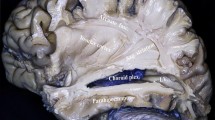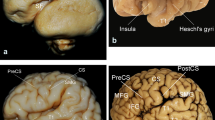Abstract
Purpose
The purpose of our study is to compare cadaver dissections with in vivo diffusion tensor imaging (DTI) to determine the position of the cervicomedullary junction (CMJ) relative to the readily identified anatomic landmarks, namely the obex and olivary bodies (olives), in normal subjects. The information gained from this study would allow further investigation into abnormalities of the CMJ, such as Chiari malformation, without the need for time-intensive tractography studies.
Methods
Six formalin-fixed human cadaver brains were compared with DTI studies in 15 normal controls. Measurements were made from the upper border of the crossing fibers of the pyramidal decussation to both the obex and the inferior margin of the olive.
Results
For the cadaver specimens, the average distance from the inferior border of the olive to the upper border of the decussation measured 3.7 mm (±1.2 mm). The average distance from the obex to the upper decussation was 6.7 mm (±2.1 mm). In the DTI subjects, the inferior olive to the upper decussation averaged 3.4 mm (±0.9 mm). The distance from the obex to the decussation averaged 6.4 mm (±1.3 mm).
Conclusion
The CMJ reliably lies 3.4 mm (±0.9 mm) caudal to the inferior border of the olive and 6.4 mm (±1.3 mm) caudal to the obex. Awareness of this anatomic relationship readily allows recognition of abnormalities of the position of the CMJ with routine imaging.




Similar content being viewed by others
References
Alexander DC, Barker GJ, Arridge SR (2002) Detection and modeling of non-Gaussian apparent diffusion coefficient profiles in human brain data. Magn Reson Med 48(2):331–340
Barkovich AJ, Wippold FJ, Sherman JL, Citrin CM (1986) Significance of cerebellar tonsillar position on MR. AJNR Am J Neuroradiol 7(5):795–799
Chiari H (1891) Über Veränderungen des Kleinhirns infolge von Hydrocephalie des Grosshirns. Dtsch Med Wochenschr 17:1172–1175
el Gammal T, Mark EK, Brooks BS (1988) MR imaging of Chiari II malformation. AJR Am J Roentgenol 150(1):163–170
Feinberg DA, Moeller S, Smith SM, Auerbach E, Ramanna S, Gunther M, Glasser MF, Miller KL, Ugurbil K, Yacoub E (2010) Multiplexed echo planar imaging for sub-second whole brain FMRI and fast diffusion imaging. PLoS One 5(12):e15710
Fischl B (2012) FreeSurfer. NeuroImage 62(2):774–781
Glasser MF, Sotiropoulos SN, Wilson JA, Coalson TS, Fischl B, Andersson JL, Xu J, Jbabdi S, Webster M, Polimeni JR, Van Essen DC, Jenkinson M (2013) The minimal preprocessing pipelines for the Human Connectome Project. NeuroImage 80:105–124
Jenkinson M, Beckmann CF, Behrens TE, Woolrich MW, Smith SM (2012) FSL. NeuroImage 62(2):782–790
Kannegieter LS, Dietrich RB, Pais MJ, Goldenberg TM (1994) Pediatric case of the day. Chiari III malformation. Radiographics 14(2):452–454
King MD, Houseman J, Roussel SA, van Bruggen N, Williams SR, Gadian DG (1994) q-Space imaging of the brain. Magn Reson Med 32(6):707–713
Messori A, Simonetti BF, Regnicolo L, Di Bella P, Logullo F, Salvolini U (2001) Spontaneous intracranial hypotension: the value of brain measurements in diagnosis by MRI. Neuroradiology 43(6):453–461
Moeller S, Yacoub E, Olman CA, Auerbach E, Strupp J, Harel N, Ugurbil K (2010) Multiband multislice GE-EPI at 7 tesla, with 16-fold acceleration using partial parallel imaging with application to high spatial and temporal whole-brain fMRI. Magn Reson Med 63(5):1144–1153
Quisling RG, Quisling SG, Mickle JP (1993) Obex/nucleus gracilis position: its role as a marker for the cervicomedullary junction. Pediatr Neurosurg 19(3):143–150
Seizeur R, Wiest-Daessle N, Prima S, Maumet C, Ferre JC, Morandi X (2012) Corticospinal tractography with morphological, functional and diffusion tensor MRI: a comparative study of four deterministic algorithms used in clinical routine. Surg Radiol Anat 34(8):709–719
Setsompop K, Gagoski BA, Polimeni JR, Witzel T, Wedeen VJ, Wald LL (2012) Blipped-controlled aliasing in parallel imaging for simultaneous multislice echo planar imaging with reduced g-factor penalty. Magn Reson Med 67(5):1210–1224
Spinos E, Laster DW, Moody DM, Ball MR, Witcofski RL, Kelly DL Jr (1985) MR evaluation of Chiari I malformations at 0.15 T. AJR Am J Roentgenol 144(6):1143–1148
Tuch DS, Reese TG, Wiegell MR, Makris N, Belliveau JW, Wedeen VJ (2002) High angular resolution diffusion imaging reveals intravoxel white matter fiber heterogeneity. Magn Reson Med 48(4):577–582
Van Essen DC, Ugurbil K, Auerbach E, Barch D, Behrens TE, Bucholz R, Chang A, Chen L, Corbetta M, Curtiss SW, Della Penna S, Feinberg D, Glasser MF, Harel N, Heath AC, Larson-Prior L, Marcus D, Michalareas G, Moeller S, Oostenveld R, Petersen SE, Prior F, Schlaggar BL, Smith SM, Snyder AZ, Xu J, Yacoub E (2012) The Human Connectome Project: a data acquisition perspective. NeuroImage 62(4):2222–2231
Vulliemoz S, Raineteau O, Jabaudon D (2005) Reaching beyond the midline: why are human brains cross wired? Lancet Neurol 4(2):87–99
Watanabe A, Horikoshi T, Uchida M, Koizumi H, Yagishita T, Kinouchi H (2009) Diagnostic value of spinal MR imaging in spontaneous intracranial hypotension syndrome. AJNR Am J Neuroradiol 30(1):147–151
Wedeen VJ, Wang RP, Schmahmann JD, Benner T, Tseng WY, Dai G, Pandya DN, Hagmann P, D’Arceuil H, de Crespigny AJ (2008) Diffusion spectrum magnetic resonance imaging (DSI) tractography of crossing fibers. NeuroImage 41(4):1267–1277
Wiegell MR, Larsson HB, Wedeen VJ (2000) Fiber crossing in human brain depicted with diffusion tensor MR imaging. Radiology 217(3):897–903
Wolpert SM, Scott RM, Platenberg C, Runge VM (1988) The clinical significance of hindbrain herniation and deformity as shown on MR images of patients with Chiari II malformation. AJNR Am J Neuroradiol 9(6):1075–1078
Xu JMS, Strupp J, Auerbach E, Feinberg DA, Ugurbil K, Yacoub E (2012) Highly accelerated whole brain imaging using aligned-blipped-controlled-aliasing multiband EPI. Proc Int Soc Magn Reson Med 20:2306
Yamazaki Y, Tachibana S, Takano M, Fujii K (1998) Clinical and neuroimaging features of Chiari type I malformations with and without associated syringomyelia. Neurol Med Chir 38(9):541–546 Discussion 546–547
Yeh FC, Tseng WY (2013) Sparse solution of fiber orientation distribution function by diffusion decomposition. PLoS One 8(10):e75747
Yeh FC, Wedeen VJ, Tseng WY (2010) Generalized q-sampling imaging. IEEE Trans Med Imaging 29(9):1626–1635
Acknowledgments
Data were provided [in part] by the Human Connectome Project, WU-Minn Consortium (Principal Investigators: David Van Essen and Kamil Ugurbil; 1U54MH091657) funded by the 16 NIH Institutes and Centers that support the NIH Blueprint for Neuroscience Research; and by the McDonnell Center for Systems Neuroscience at Washington University.
Conflict of interest
The authors declare that they have no conflict of interest.
Ethical standard
The submitted study was in compliance with the current laws of the authors’ country. The study was exempted from full IRB review by meeting University of Florida IRB requirements for exemption.
Author information
Authors and Affiliations
Corresponding author
Rights and permissions
About this article
Cite this article
Middlebrooks, E.H., Yagmurlu, K., Bennett, J.A. et al. Normal relationship of the cervicomedullary junction with the obex and olivary bodies: a comparison of cadaveric dissection and in vivo diffusion tensor imaging. Surg Radiol Anat 37, 493–497 (2015). https://doi.org/10.1007/s00276-014-1387-2
Received:
Accepted:
Published:
Issue Date:
DOI: https://doi.org/10.1007/s00276-014-1387-2




